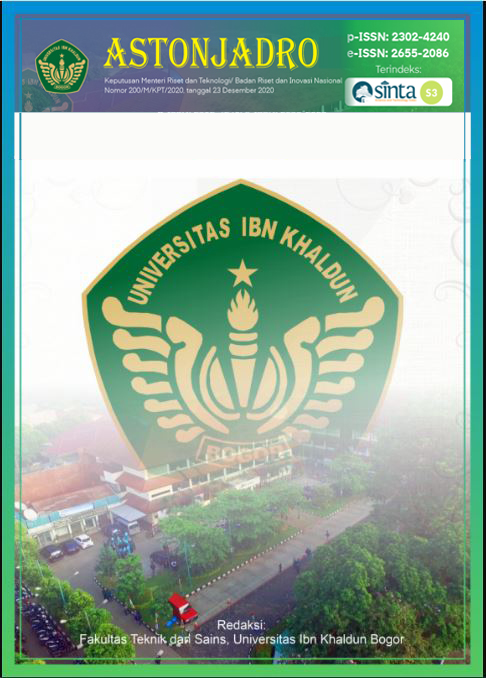Impact of Traffic Congestion on Road Users in Tangerang City
DOI:
https://doi.org/10.32832/astonjadro.v11i3.7428Keywords:
congestion, accessibility, mobility, structural equation modeling.Abstract
One of the negative impacts of transportation problems is congestion. Traffic congestion in urban areas is gradually becoming an important social and economic problem that needs to be addressed. Tangerang City is one of the supporting cities for the Jakarta metropolitan area as well as an area with a significant increase in population and vehicles, resulting in an increase in the number of people's movements or mobility in order to meet the needs of life. Meanwhile, the length of roads in Tangerang City during 2018-2019 did not increase and it is possible that there will be an imbalance between movement and available road capacity or minimal accessibility. The research approach used is quantitative with primary data sources obtained from closed questionnaire instruments from 180 road user respondents at the TangCity Mall intersection, Tangerang City. Analysis of the data used is a structural equation model with the AMOS 22.00 program to determine the factors that influence the impact of congestion. The results of the analysis show that the factors that most influence the impact of congestion are decreased concentration and loss of energy during traffic jams, which are more common in men who are married at the age of over 35 years, with a diploma level of education, as well as the type of work as a Civil Servant.References
Anjasmoro, D. A. (2018). Analisis Kinerja Lalu Lintas pada Simpang Bersinyal dan Ruas Jalan KS Tubun - Jalan Jembatan Baru Kota Tangerang (Tugas Akhir). Jakarta: Universitas Mercu Buana.
Aulia, M. (2016). Analisis Dampak Sosial Ekonomi Pengguna Jalan Akibat Kemacetan Lalu Lintas di Banda Aceh. Jurnal Ekonomi Dan Kebijakan Publik, 3(1), 26–33.
BPS Kota Tangerang. (2020). Kota Tangerang dalam Angka 2020. Badan Pusat Statistik Kota Tangerang. Retrieved from https://tangerangkota.bps.go.id/publikasi.html
BPS Provinsi Banten. (2020). Provinsi Banten Dalam Angka 2020. Kota Serang: Badan Pusat Statistik Provinsi Banten.
C Jalagat, R. C., & M Jalagat, A. M. (2016). Causes and Effects of Traffic Jam in Muscat City, Sultanate of Oman. 5(12), 2015–2017.
Cheng, Y. H., Chang, Y. H., & Lu, I. J. (2015). Urban transportation energy and carbon dioxide emission reduction strategies. Applied Energy, 157, 953–973. https://doi.org/10.1016/j.apenergy.2015.01.126
Fields, G., Hartgen, D., Moore, A., & Poole, R. W. (2009). Relieving congestion by adding road capacity and tolling. International Journal of Sustainable Transportation, 3(5–6), 360–372. https://doi.org/10.1080/15568310802260013
Haryono, S., 2016. Metode SEM: AMOS, LISREL, PLS. Jakarta: PT. Intermedia Personalia Utama.
Hidayat, R., & H, D. S. A. (2017). Dampak Kemacetan Terhadap Sosial Ekonomi Pengguna Jalan Di Kota Banda Aceh. Jurnal Ilmiah Mahasiswa (JIM), 2(1), 176–186.
Indrashanty, A., & Legowo, P. S. (2017). Aksesibilitas dan Mobilitas Transportasi di Provinsi Bengkulu dalam Konteks Negara Maritim dan Penguatan Daerah Tertinggal. Jurnal Transportasi Multimoda, 95–104. Retrieved from http://202.61.104.165/index.php/jurnalmtm/article/view/171
Jenderal Bina Marga, D. (1997). Highway Capacity Manual Project (HCM). Manual Kapasitas Jalan Indonesia (MKJI), 1(I), 564
Kadarisman, M., Gunawan, A., & Ismiyati, I. (2017). Implementasi Kebijakan Sistem Transportasi Darat Dan Dampaknya Terhadap Kesejahteraan Sosial Di Jakarta. Jurnal Manajemen Transportasi Dan Logistik, 2(1), 59. https://doi.org/10.25292/j.mtl.v2i1.129
Kawulur, D. O. M., Naukoko, A. T., & Maramis, M. T. B. (2020). Analisis Dampak Kemacetan Terhadap Ekonomi Pengguna Jalan, Depan Tugu Taman Kota Manado. Jurnal Berkala Ilmiah Efisiensi, 20(01), 83–93.
Le, T. P. L., & Trinh, T. A. (2016). Encouraging public transport use to reduce traffic congestion and air pollutant: A case study of Ho Chi Minh City, Vietnam. Procedia Engineering, 142, 236–243. https://doi.org/10.1016/j.proeng.2016.02.037
Nadrian, H., Taghdisi, M. H., Pouyesh, K., Khazaee-Pool, M., & Babazadeh, T. (2019). "I am sick and tired of this congestion”: Perceptions of Sanandaj inhabitants on the family mental health impacts of urban traffic jam. Journal of Transport and Health, 14(September), 100587. https://doi.org/10.1016/j.jth.2019.100587
Narotikah, W., Atikah, C. N., & Ponrahono, Z. (2019). The Effect of Traffic Congestion on Quality of Community Life. 1–11.
Nuryanto, W. E. (2019). Analisis Kinerja Ruas Jalan Teuku Umar dan Simpang Bersinyal Shinta Kota Tangerang (Tugas Akhir). Jakarta: Universitas Mercu Buana.
Roberts, M., Sander, F. G., & Tiwari, S. (2019). Time to ACT : Realizing Indonesia's Urban Potential. Washington DC: The World Bank.
Su, Y., Liu, X., Li, X., & Oh, K. (2020). Research on Traffic Congestion Based on System Dynamics: The Case of Chongqing, China. Complexity, 2020. https://doi.org/10.1155/2020/6123896
Sugiyanto, G., Malkhamah, S., Munawar, A., & Sutomo, H. (2011). Model Biaya Kemacetan Bagi Pengguna Mobil Pribadi Di Kawasan Malioboro, Yogyakarta. 11(1), 81–86. Retrieved from https://publikasiilmiah.ums.ac.id/bitstream/handle/11617/1940/_13_ Gito - Unsoed_revised.pdf?sequence=1&isAllowed=y
Susanti, S. (2015). Estimasi biaya kemacetan di kota medan. Jurnal Penelitian Transportasi Multimoda, 13(5), 21–30. https://doi.org/10.1093/gerona/gls094
T
amara, S., & Sasana, H. (2017). Analisis Dampak Ekonomi Dan Sosial Akibat Kemacetan Lalu Lintas Di Jalan Raya Bogor-Jakarta. Jurnal REP (Riset Ekonomi Pembangunan), 2(2), 185–196. https://doi.org/10.31002/rep.v2i3.529
Tamin, O. Z. (2008). Perencanaan, Pemodelan & Rekayasa Transportasi. Bandung: Institut Teknologi Bandung.
Zhang, K., & Batterman, S. (2013). Air pollution and health risks due to vehicle traffic. Science of the Total Environment, 450–451, 307–316. https://doi.org/10.1016/j.scitotenv.2013.01.074
Downloads
Published
How to Cite
Issue
Section
License
Copyright (c) 2022 ASTONJADRO: CEAESJ

This work is licensed under a Creative Commons Attribution-ShareAlike 4.0 International License.
Paper submitted to ASTONJADRO is the sole property of the Astonjadro Journal. Unless the author withdraws the paper because he does not want to be published in this journal. The publication rights are in the journal Astonjadro.ASTONJADRO
LICENSE
This work is licensed under a Creative Commons Attribution-ShareAlike 4.0 International License.
Based on a work at http://ejournal.uika-bogor.ac.id/index.php/ASTONJADRO













